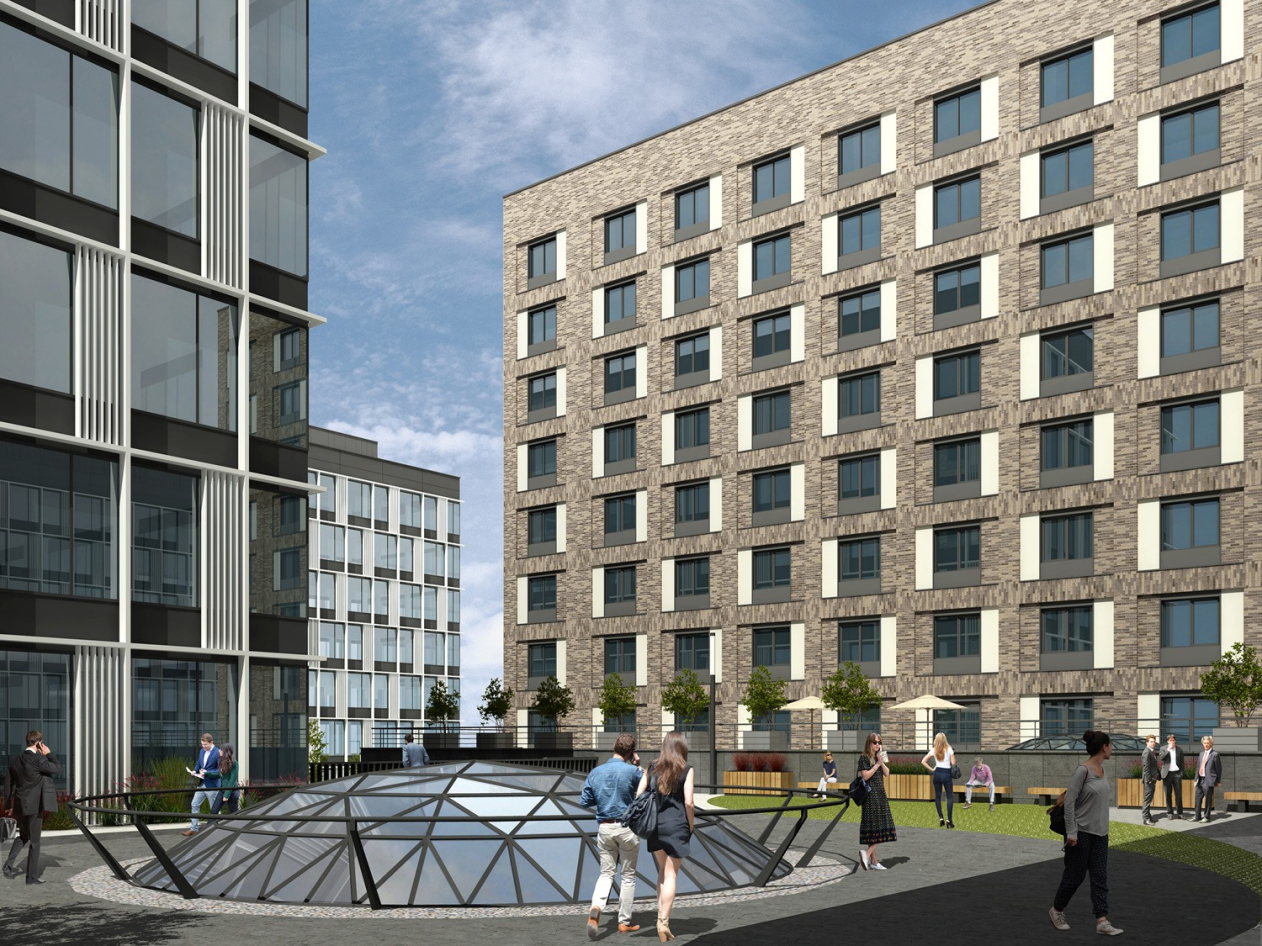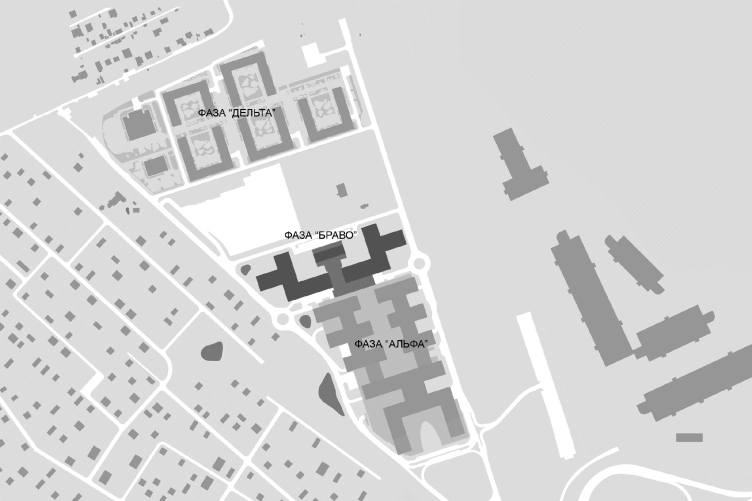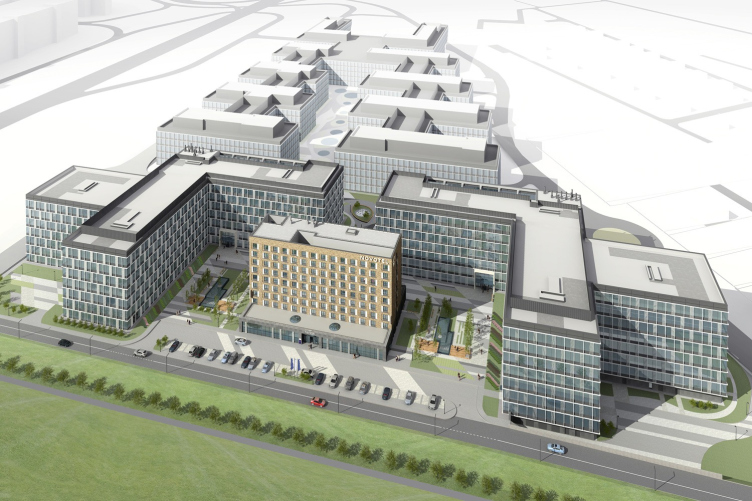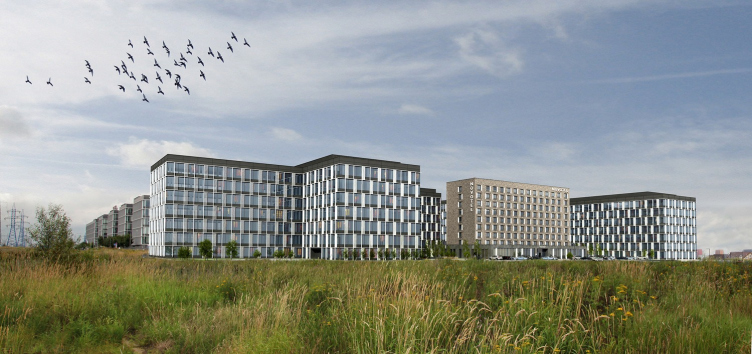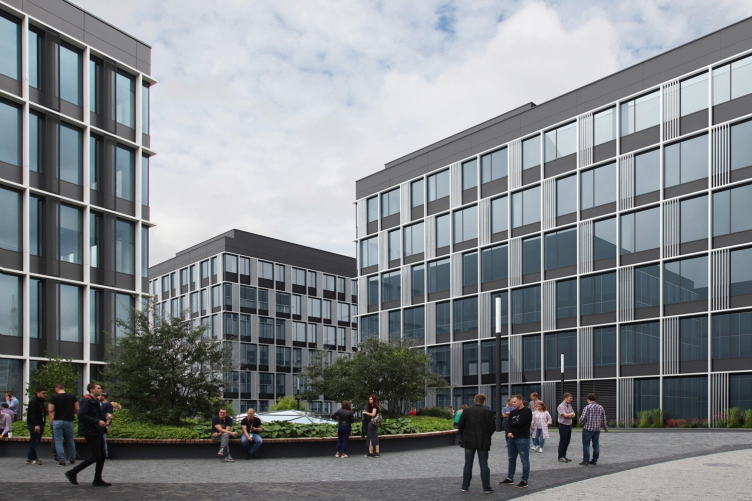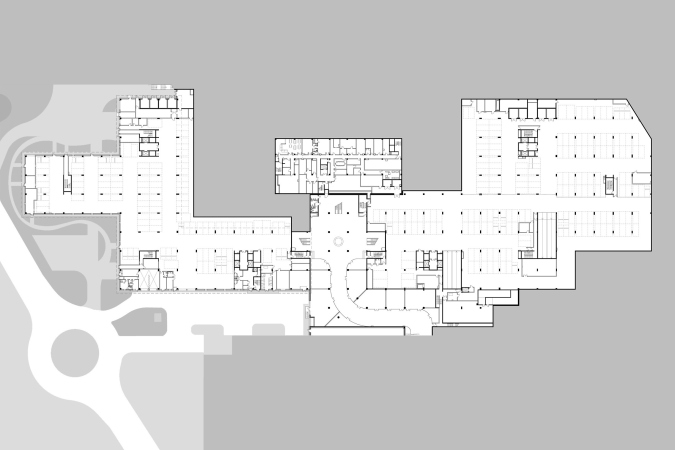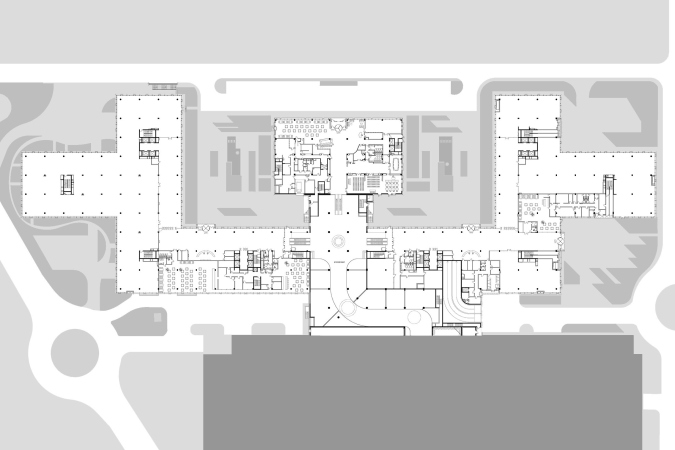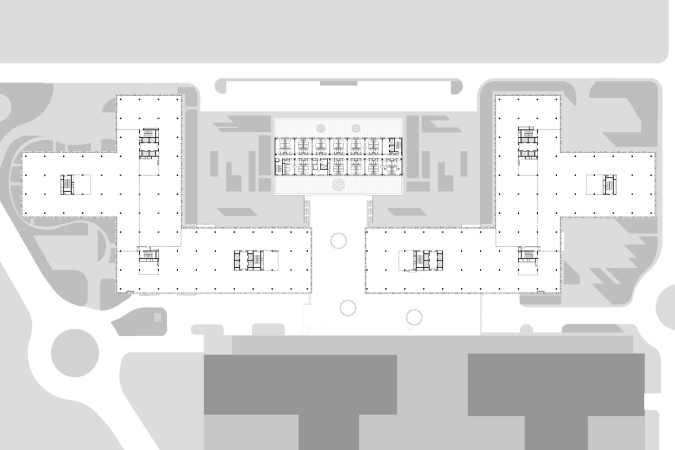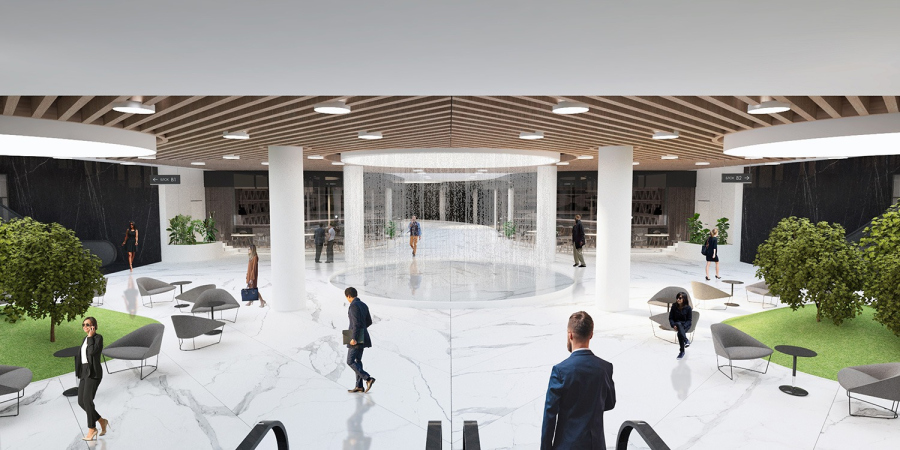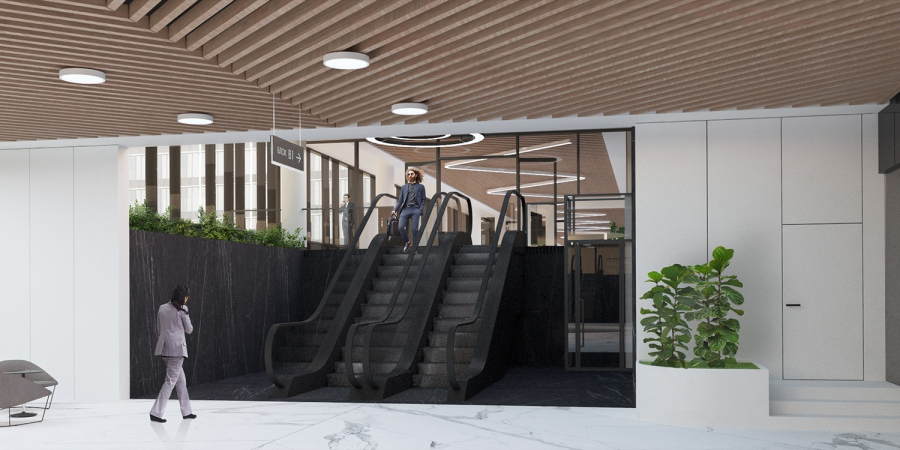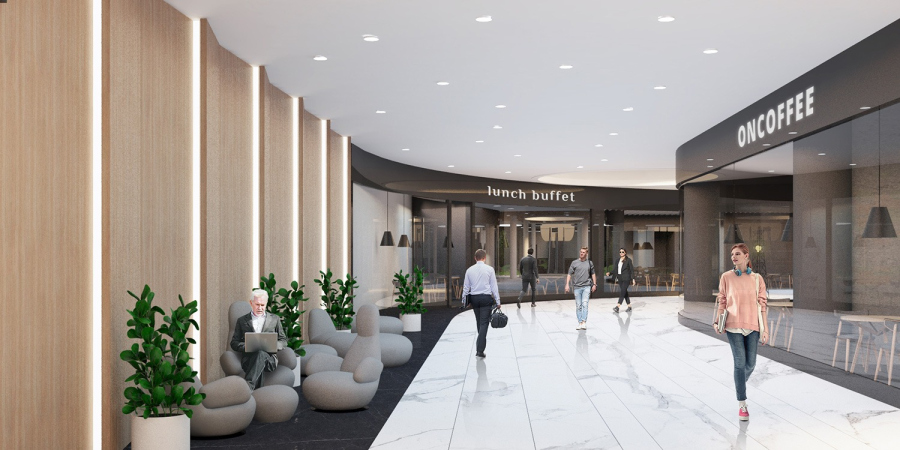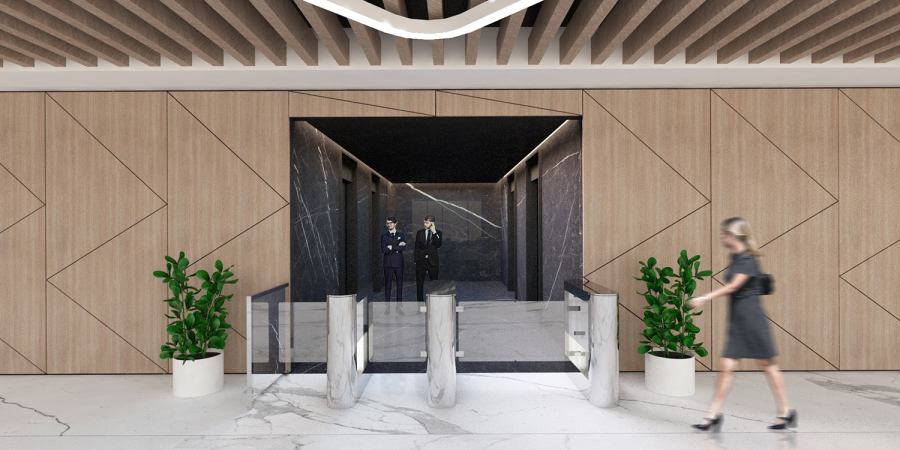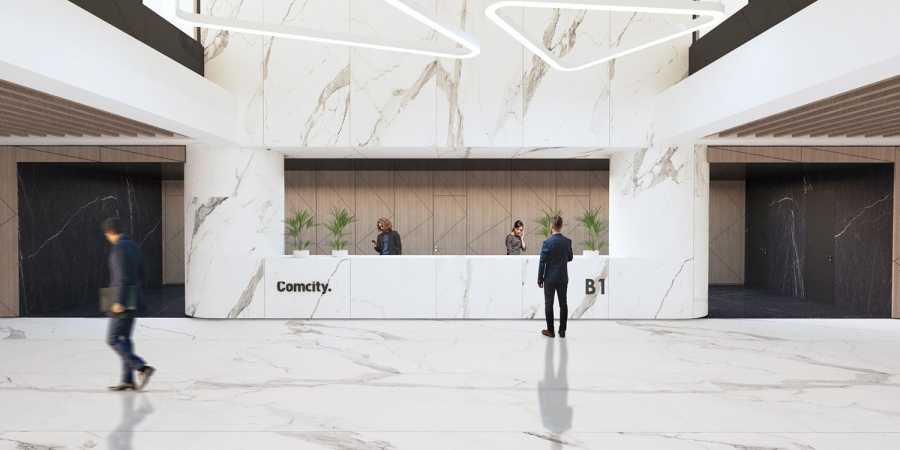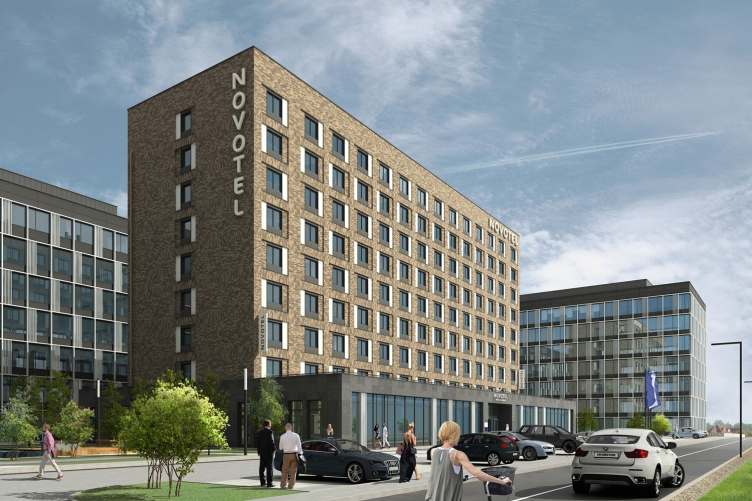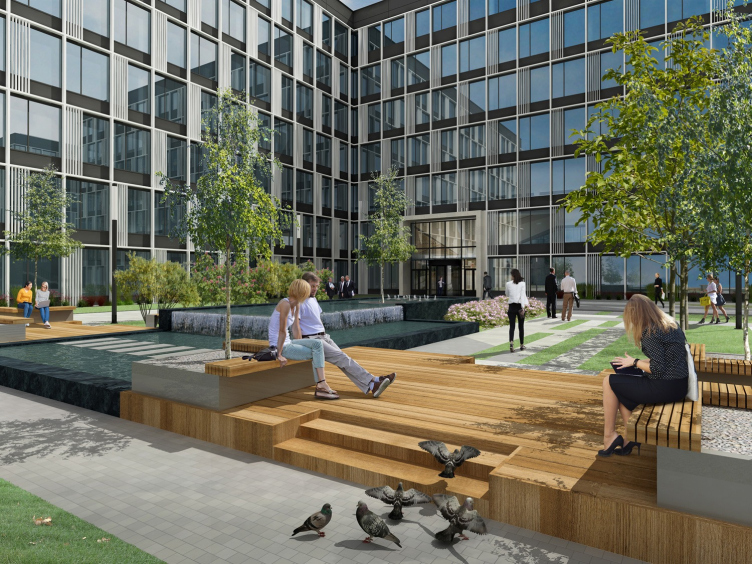Then, in 2016, the developers invited the architects of Sergey Kiselev and Partners to work with this territory, who first of all helped to reconsider its functional zoning – and this is how a small residential complex appeared within the business park. Then Sergey Kiselev and Partners began working on three individual land sites, sliced like the layers of Maslow’s Pyramid, parallel to the highway and sideways to the axis of the acute triangle of the entire territory. The housing complex is situated the farthest away from the highway; it must be later joined by the Charlie office complex, which will be designed and built last.
The project of the office building and the hotel of the Bravo phase are already complete; its construction is going at a record-breaking rate, and we are covering it in this article.
Location plan. COMCITY office complex
Copyright: © Sergey Kisselev and partners
Bravo continues the Alpha building volume-, planning-, and composition-wise. This makes a lot of sense because Alpha has long since run out of vacant premises. This complex, masterfully designed to meet the needs of telecommunication companies, occupied the profitable niche, being one of the first to propose the “office park” format, i.e. self-sufficient infrastructure in the eco-friendly theme.
The total area of the “Bravo Phase” is about 103,000 square meters; it will be occupied by three buildings – two blocks of offices and a hotel with an extensive underground space. Crucially important is the fact that the already existing “underground shopping street”, which belongs to Alpha, will eventually join the Bravo inner gallery. The composition of the buildings follows that of Alpha, keeping the axial symmetry: the two office wings B1 and B2, looking like two stylized palms of human hands, “embrace” the 150-room Novotel hotel. Two inner plazas appear between the side ends of the hotel and the office buildings.
Bravo phase. COMCITY office complex
Copyright: © Sergey Kisselev and partners
Together, Alpha and Bravo form a mega-structure of volumes tied into a single city block that supports the 24/7 life of the resident companies. The composition of Bravo unfolds in space in accordance with the set logic. For example, the main block of Alpha is symmetrical; hence, buildings B1 and B2 are as well; they look like a curious echo from beginning to end of the entire complex.
Bravo phase. COMCITY office complex
Copyright: © Sergey Kisselev and partners
Both composition and architecture-wise, the second stage of construction avoids direct quotes from Alpha, yet similar techniques are easily observed. For example, B1 and B2 use similar superimposed grids: one from dark-colored aluminum panels, and one from slim metallic profile ribs. The highlights here are vertical grilles situated next to the windows, which liven up the rhythm. The black color and metal, however, noticeably resonate with the facades of Alpha and allow us to perceive the buildings of Bravo as not only its structural continuation, but a visual one as well.
Bravo phase. COMCITY office complex
Copyright: © Sergey Kisselev and partners
Bravo phase. COMCITY office complex
Copyright: © Sergey Kisselev and partners
At the client’s decision, the office premises will be divided into three lots. Trying to make sure that not a single square meter of useful floor space goes to waste, the architects subjected all of the spaces to free planning – there are no corridors inside; there are two elevator/staircase blocks, plus two more staircases per 5,000 square meters of the standard floor of each building – shares Anastasia Khomyakova – The units turned out to be compact, with all the utility lines grouped around them.
In addition, Bravo continues the idea of vertical zoning – the semi-basement public level designed as a covered pedestrian promenade, lit by skylights. Actually, this is the “city within a city”, the way Comcity positions itself; this place is open to the public, you can walk around the shops here, the office turnstiles shifted closer to the elevator halls. The stream of people flows into the gallery from the direction of the main Alpha entrance and through the semicircular “funnel” of the stylobate; further on, it can go through the entire city block, and, passing the bend, end up in the Bravo buildings.
On the inside, the white color is combined with living plants and light-colored wood, while the central atrium will feature a fountain with a waterfall flowing down from the skylight on top of the dome.
The hotel, as a building that is predominantly residential, unlike the uptight technological-looking offices, got Clinker tile facades, on which different shades of ochre are blended together to form a mottled carpet with white fiber cement inserts – such a combination obviously resonates with the Homecity housing complex that is being built nearby. At the same time, the basement part of the hotel becomes the continuation of the stylobate and the offices, and will be likewise coated with ceramic granite.
Bravo phase. COMCITY office complex
Copyright: © Sergey Kisselev and partners
The semi-basement inner link between Alpha and Bravo buildings is echoed by the upper pedestrian street on top of the stylobate – the authors of Bravo continue the development that already exists on the stylobate of Alpha, using plants of the same type and similar small-form architecture, which, among other things, helps decorate the skylight domes.
Bravo phase. COMCITY office complex
Copyright: © Sergey Kisselev and partners
Bravo phase. The landscaping plan. COMCITY office complex
Copyright: © Sergey Kisselev and partners
Passing between the office buildings, the upper street exits to the slab of the hotel, and here the stream splits in two: you can swerve left or right to find yourself at one of the two plazas, seemingly identical yet different in details. These open up north, to the driveway between Bravo and the future Charlie. The authors interpret these plazas as grand courtyards, or cours d’honneur; each one sports a fountain, green plants, and a small amphitheater. Over here, to the north, the portals of the main entrances of the office buildings are turned – frames of light-colored stone, the two-level height of which, a little under 8 meters, responds to the just impressive and spacious height of the entrance lobbies inside.
Bravo phase. COMCITY office complex
Copyright: © Sergey Kisselev and partners
As we can see, the “phase Bravo” serves as the connecting link of the complex: like a curious joint, it not only picks up and develops the positive ideas of the existing building but also, “over the head” of the “phase Charlie”, a project that is yet nonexistent, resonates with the Homecity housing complex that is also in construction. All of these things put together must boost the growth and development of the business park, situated not far away from Moscow Ring Road, and already fairly popular – probably not just because of the favorable location but also thanks to a modern compound structure of spaces belonging to the significant, however small, business city, which in the new projects get logical development and completion.

